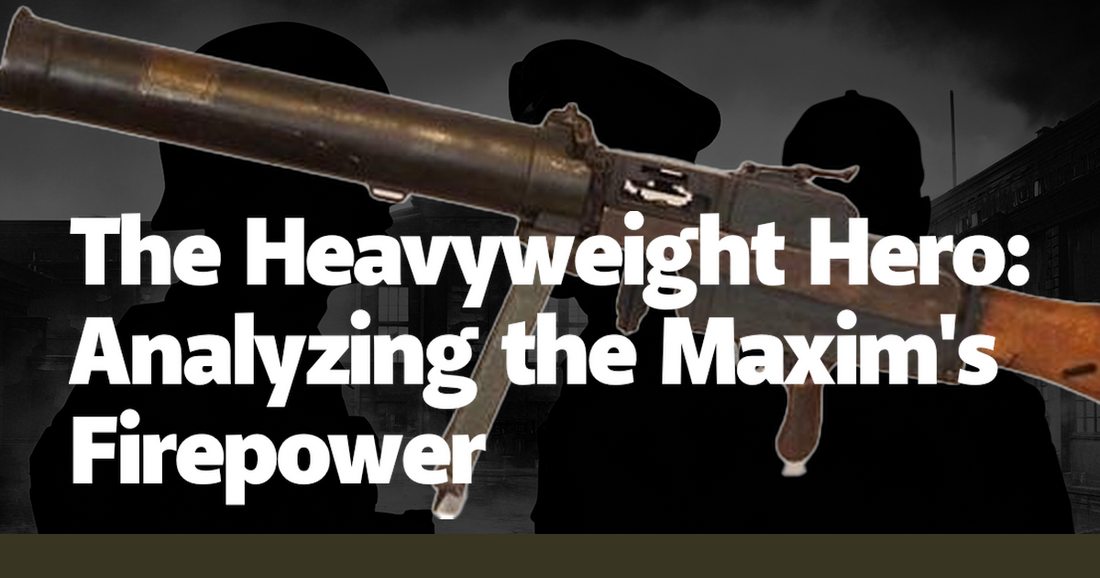The Maxim machine gun, often hailed as the 'heavyweight hero' of early modern warfare, revolutionized the battlefield with its unprecedented firepower. Conceived by Sir Hiram Maxim in 1884, this formidable weapon marked a significant departure from manual, single-shot rifles, epitomizing the brutal efficiency of industrialized warfare. The Maxim's design was ingenious in its simplicity and devastating in its effectiveness. It utilized the recoil force from each shot to eject the spent cartridge and chamber the next round, enabling sustained rapid fire. This innovation meant that a single Maxim gun could unleash up to 600 rounds per minute, a rate that was unthinkable with previous manually operated firearms. This dramatic increase in firepower fundamentally altered military tactics and strategies, forcing armies to rethink their approach to both offense and defense.
The impact of the Maxim gun was first felt during the colonial conflicts of the late 19th century, where European powers wielded it with ruthless efficiency against indigenous forces. In the Battle of Omdurman in 1898, for example, British forces equipped with Maxim guns decimated the Mahdist army. The British, numbering around 8,000, faced a Sudanese force of approximately 50,000. The Maxim's relentless barrage mowed down wave after wave of Mahdist warriors, resulting in a lopsided casualty count that starkly demonstrated the lethal potential of automatic firepower. This battle, among others, underscored the brutal reality that technological superiority could render traditional forms of warfare obsolete almost overnight.
As the Maxim gun proliferated, it became a symbol of both technological progress and the horrifying destructiveness of modern warfare. During World War I, the full extent of the Maxim's influence was realized on the Western Front. The static, trench-bound nature of the conflict provided the perfect environment for the Maxim to unleash its deadly capabilities. Machine gun nests became the backbone of defensive positions, creating deadly kill zones that made frontal assaults extraordinarily costly. The Battle of the Somme in 1916 is a grim testament to this. On the first day alone, the British Army suffered nearly 60,000 casualties, many of whom fell victim to the unrelenting fire of German Maxim guns. The sheer scale of the carnage wrought by these weapons forced military planners to seek new tactics and technologies to break the deadlock.
The psychological impact of the Maxim gun on soldiers cannot be overstated. The relentless, mechanical chattering of its fire became synonymous with the horror of the trenches. Veterans often spoke of the 'devil's paintbrush,' a nickname that vividly captured the weapon's ability to sweep away life with terrifying ease. Anecdotes from the front lines frequently recount the demoralizing effect of facing a Maxim gun, where the mere sound of its fire could halt an advance and send men scrambling for cover. This psychological warfare element, combined with its physical lethality, made the Maxim a weapon that dominated the battlefield both materially and mentally.
Despite its fearsome reputation, the Maxim gun was not without its limitations. It was a heavy and cumbersome piece of equipment, often requiring a crew of several men to operate and transport. This logistical challenge meant that while it was devastating in defensive positions, its mobility was limited. To mitigate this, various adaptations and lighter versions were developed over time. For instance, the Vickers machine gun, a British adaptation of the Maxim, retained the original's reliability while being slightly more manageable in the field. These iterations ensured that the basic principles of the Maxim's design continued to influence machine gun development well into the 20th century.
The legacy of the Maxim gun extends beyond its immediate battlefield impact. It set the stage for the development of more advanced automatic weapons, influencing designs that would see use in conflicts throughout the 20th and 21st centuries. The principles of automatic fire and recoil operation pioneered by Maxim are evident in modern machine guns, from the M2 Browning to the ubiquitous AK-47. The Maxim's emphasis on sustained firepower and mechanical reliability remains a cornerstone of military small arms design. This enduring legacy highlights the profound and lasting influence of Maxim's invention on the evolution of warfare.
In analyzing the Maxim's firepower, it's crucial to consider its broader implications on military doctrine and international relations. The advent of the Maxim gun contributed to an arms race that saw nations scrambling to develop and deploy increasingly sophisticated weaponry. This escalation in military technology played a significant role in shaping the geopolitical landscape of the early 20th century, as nations sought to outdo each other in a bid for global dominance. The Maxim gun, therefore, was not just a weapon of war but a catalyst for a broader transformation in how wars were fought and how nations perceived military power.
Ultimately, the Maxim machine gun stands as a testament to the dual-edged nature of technological progress. While it brought about significant advancements in military capability, it also introduced new levels of destruction and suffering. Its story is a reminder of the profound impact that a single technological innovation can have on the course of history. The Maxim gun's firepower, both feared and revered, remains a powerful symbol of the relentless march of military technology and the enduring quest for dominance on the battlefield.

